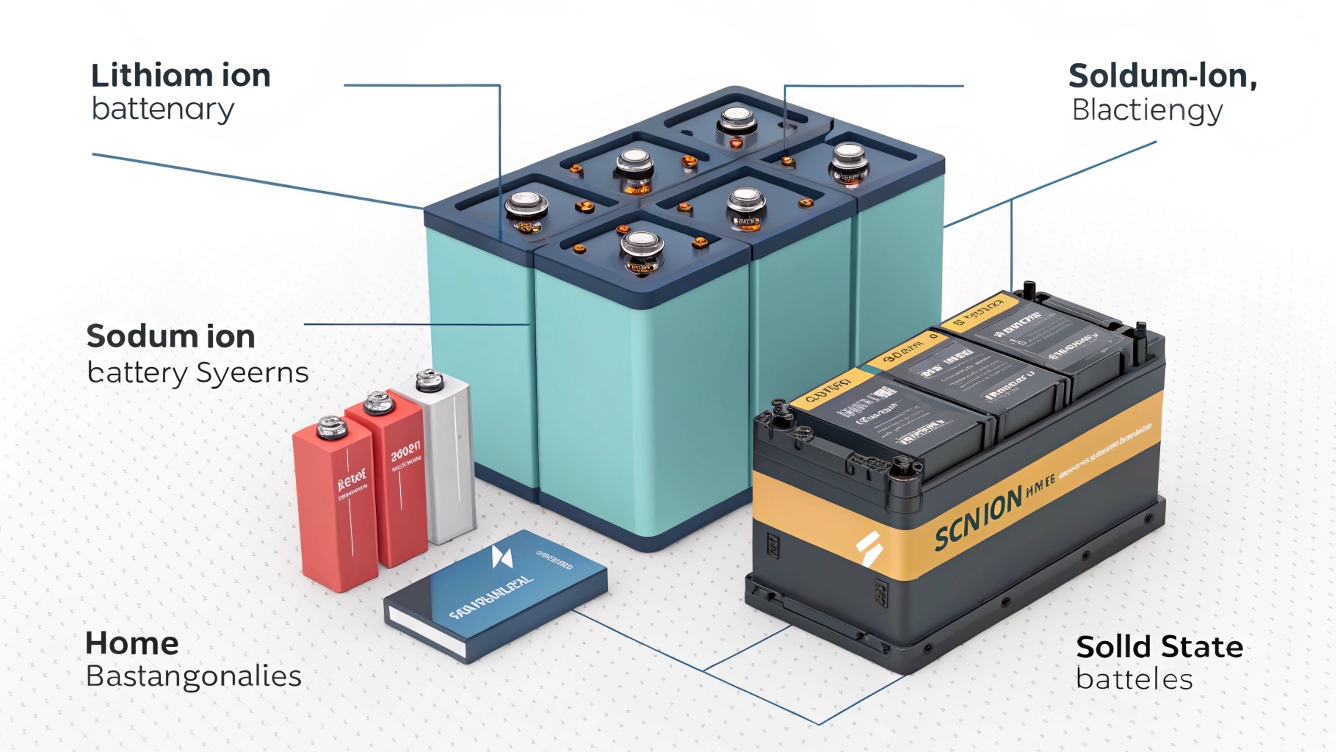Ce qui fait une meilleure batterie que le lithium? Explorer des alternatives pour un avenir durable
Pourquoi le monde a besoin d'alternatives aux batteries lithium-ion
Les batteries lithium-ion alimentent tout, des smartphones aux véhicules électriques, depuis des décennies. Mais avec une demande croissante, préoccupations environnementales, et les goulots d'étranglement de la chaîne d'approvisionnement, les chercheurs et les industriels s’empressent de développer des alternatives. Passons aux plus prometteurs types de batterie des technologies sur le point de remodeler le stockage d’énergie.
Batteries sodium-ion: Le concurrent rentable
Comment fonctionne le sodium-ion
Les batteries sodium-ion fonctionnent de la même manière que les batteries lithium-ion, en utilisant des ions sodium (Na+) au lieu des ions lithium (Li +) stocker de l'énergie. L’abondance du sodium : c’est 1,000 fois plus courant que le lithium, ce qui en fait une alternative rentable:citer[3]:citer[8].
Avantages clés:
- Coût inférieur: Les sels de sodium sont moins chers que les composés de lithium, réduisant les coûts des matières premières jusqu'à 30%:citer[7]:citer[10].
- Sécurité: Moins sujet à l’emballement thermique, ce qui les rend idéaux pour le stockage sur réseau et les véhicules électriques à faible vitesse:citer[8]:citer[9].
- Performance à froid: Fonctionne efficacement à -20°C, contrairement aux batteries au lithium qui luttent par temps glacial:citer[9].
Limites:
- Densité énergétique: Les batteries sodium-ion actuelles offrent ~160 Wh/kg, bien en dessous du lithium 250+ Wh/kg:citer[7]:citer[10].
- Cycle de vie: Généralement 1 500 à 2 000 cycles, par rapport au phosphate de fer et de lithium (LFP) piles' 6,000+ cycles:citer[7].
Mieux pour: Stockage stationnaire, vélos électriques, et systèmes d'alimentation de secours où le poids n'est pas critique.
Batteries à semi-conducteurs: La révolution de la sécurité
Décomposer la technologie à semi-conducteurs
Les batteries à semi-conducteurs remplacent les électrolytes liquides inflammables par des matériaux solides comme la céramique ou les polymères. Cette conception élimine les risques d'incendie et augmente la densité énergétique:citer[8].
Pourquoi ils changent la donne:
- Sécurité: L'absence d'électrolytes liquides signifie zéro risque de fuite ou d'explosion:citer[8].
- Charge plus rapide: Possibilité de recharger les véhicules électriques en moins de 15 minutes:citer[8].
- Longévité: Les tests en laboratoire montrent 10,000+ cycles, doubler les normes actuelles en matière de lithium:citer[8].
Obstacles:
- Coût: La fabrication reste coûteuse en raison de matériaux rares comme les sulfures:citer[8].
- Évolutivité: La production de masse est encore en phase pilote, avec des entreprises comme Toyota ciblant 2027 pour la commercialisation:citer[8].
Mieux pour: Véhicules électriques hautes performances et aviation où la sécurité et la densité énergétique ne sont pas négociables.
Lithium-Soufre (Li-S) Batteries: Des centrales légères
La chimie derrière le Li-S
Les batteries lithium-soufre utilisent des cathodes de soufre, qui sont plus légères et moins chères que les cathodes traditionnelles à base de nickel ou de cobalt.
Points forts:
- Densité énergétique: Limite théorique de 2,500 Wh/kg : cinq fois la capacité du lithium-ion:citer[3].
- Respectueux de la nature: Le soufre est abondant et non toxique, réduire l'impact environnemental:citer[3].
Défis:
- Durée de vie courte: Le soufre se dissout pendant le cyclisme, limiter la plupart des prototypes à 200-300 cycles:citer[3].
- Commercialisation lente: Les géants de la technologie comme Oxis Energy ont eu du mal à commercialiser le Li-S:citer[3].
Mieux pour: Drones, aérospatial, et applications de niche privilégiant le poids plutôt que la longévité.
Piles de flux: La solution à l’échelle du réseau
Comment fonctionnent les batteries Flow
Les batteries à flux stockent l'énergie dans des électrolytes liquides logés dans des réservoirs externes. Ils sont rechargeables en remplaçant le fluide électrolytique.
Pourquoi ils se démarquent:
- Évolutivité illimitée: La taille du réservoir dicte la capacité, parfait pour le stockage en grille:citer[3].
- Durée de vie de plusieurs décennies: Les batteries à flux de vanadium durent 20+ années avec une dégradation minime:citer[3].
Inconvénients:
- Densité de faible énergie: Les systèmes volumineux ne conviennent pas aux appareils portables:citer[3].
- Coût initial élevé: Les prix du vanadium peuvent grimper, même si des alternatives à base de fer émergent:citer[3].
Mieux pour: Fermes solaires, stockage d'énergie éolienne, et installations industrielles nécessitant une sauvegarde de longue durée.
Systèmes de batterie modulaire: La flexibilité rencontre l'efficacité
Une taille unique ne convient pas à tous les systèmes de batteries modulaires permettent aux utilisateurs de personnaliser le stockage d'énergie. Par exemple, nos kits de stockage solaire extensibles permettent aux propriétaires de commencer petit et d'ajouter de la capacité selon leurs besoins.
Avantages de la conception modulaire:
- Évolutivité: Ajoutez des modules pour répondre à la demande énergétique croissante.
- Compatibilité hybride: Mélanger le lithium, sodium, ou des batteries à flux dans un seul système.
- Facilité d'entretien: Remplacez des unités individuelles sans arrêter l'ensemble du système.
Pour la pointe: Associez des systèmes modulaires à un logiciel de gestion de l'énergie basé sur l'IA pour optimiser les cycles de charge et prolonger la durée de vie:citer[8].
Analyse comparative: Quel type de batterie convient à vos besoins?
| Technologie | Densité énergétique (Wh/kg) | Cycle de vie | Coût ($/kWh) | Meilleur cas d'utilisation |
|---|---|---|---|---|
| Lithium-ion (LFP) | 150–200 | 6,000+ | 90–130 | VÉ, Électronique grand public |
| Sodium-ion | 120–160 | 1,500–2 000 | 70–100 | Stockage de grille, Vélos électriques |
| À l'état solide | 300–500 (projeté) | 10,000+ | 150–200 | Véhicules électriques haut de gamme, Aérospatial |
| Couler (Vanadium) | 15–25 | 20,000+ | 300–500 | Stockage à l'échelle des services publics |
Données synthétisées à partir de rapports industriels et d'études universitaires:citer[3]:citer[8]:citer[10].
L'avenir du stockage d'énergie: Solutions hybrides
Aucun type de batterie ne détrônera le lithium. Plutôt, les systèmes hybrides combinant la haute densité énergétique du lithium avec l’abordabilité du sodium ou la longévité du flux domineront. Par exemple, Solutions de stockage solaire comme notre Batterie domestique hybride intégrer des batteries au lithium et à flux pour équilibrer l'utilisation quotidienne et la sauvegarde à long terme.
Tendances émergentes à surveiller:
- Chargement optimisé par l'IA: Des algorithmes prédisent les modèles d'utilisation pour réduire l'usure:citer[8].
- Des avancées en matière de recyclage: De nouvelles méthodes de récupération 95%+ lithium provenant de vieilles piles:citer[10].
- Changements de politique: Les gouvernements subventionnent le sodium-ion pour les projets renouvelables:citer[9].
Conclusion: Choisir le bon Types de batterie pour les besoins de demain

Alors que le lithium reste roi pour l'instant, des alternatives comme les batteries sodium-ion et à semi-conducteurs se taillent des niches en matière de durabilité et de sécurité. Pour les propriétaires et les entreprises, systèmes de batteries modulaires offrir la flexibilité nécessaire pour adopter de nouvelles technologies à mesure qu’elles mûrissent.
Gycxsolar fournit des produits de batterie au lithium de haute qualité et tous les composants des systèmes d'énergie solaire aux clients du monde entier.
Des produits de haute qualité tels que des panneaux solaires et des onduleurs sont produits. Nous vous recommandons également des solutions de combinaison de systèmes plus favorables à vous.
En même temps, Nous avons des experts offrant des services de solution de conception gratuits.
Un service d'arrêt pour résoudre vos problèmes, Un service de haute qualité met le gycxsolar dans une position de premier plan dans l'industrie.
Votre consultation est la bienvenue. Le schéma de conception a toujours été très apprécié et fiable, avec une clientèle très stable. Nous choisir est un choix très sage pour vous.
Étapes suivantes:
- Calculez vos besoins énergétiques avec l'outil.
- Explorez notre Solutions de stockage sur batterie adapté à un usage résidentiel et commercial.
- Abonnez-vous à notre Chaîne YouTube pour les guides d'installation DIY et les mises à jour techniques.
Références
- Chimie des batteries sodium-ion: Wikipedia: Batterie sodium-ion.
- Données de sécurité des semi-conducteurs: Wikipedia: Batterie à semi-conducteurs.
- Avancées du lithium-soufre: Des études évaluées par des pairs dans Énergie naturelle.




